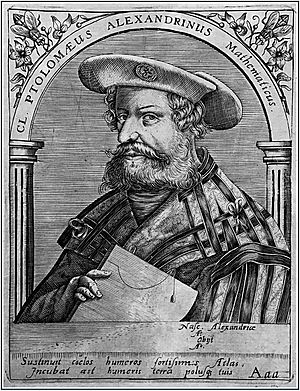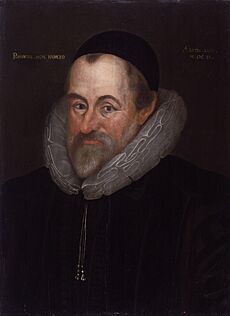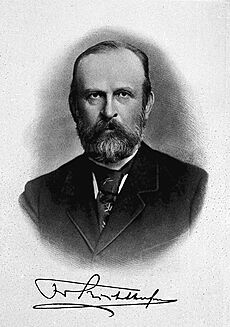Chorography facts for kids
Chorography is an old but interesting way of describing or mapping a specific area, like a region, a county, or even a city. Think of it as creating a detailed picture of a place, not just with maps, but also with words, stories, and history.
The word "chorography" comes from two ancient Greek words: khōros, meaning "place," and graphein, meaning "to write" or "to describe." So, it literally means "writing about a place."
Ancient geographers like Pomponius Mela and Ptolemy used this term to mean a geographical description of regions. It's different from a "chronicle," which is about events over time. Chorography is all about the place itself!
Contents
What Did Ptolemy Mean by Chorography?
In his famous book Geographia (written around 150 CE), Ptolemy explained the difference between geography and chorography.
- Geography for him was the study of the entire world.
- Chorography was the study of smaller parts of the world, like provinces, regions, cities, or even just a port.
Ptolemy said that chorography was like making a drawing of just one part of something, "as when one makes an image of just an ear or an eye." It focused on the qualities of a place (what it's like) rather than just its measurements (how big it is). He even suggested it needed the skills of an artist to draw views, not just technical map-making skills. Modern experts sometimes call his idea "regional cartography," which means making maps of specific regions.
How Did Chorography Return in the Renaissance?
Ptolemy's writings were rediscovered in Europe in the early 1400s, and with them, the term "chorography" became popular again among scholars during the Renaissance.
In 1570, a scholar named John Dee described chorography as a smaller part of geography, where you would create a "plat" (a plan or drawing) to show a particular place clearly.
Written Descriptions of Places
Over time, "chorography" also started to mean written descriptions of regions. Writers would travel extensively through an area, then combine:
- Descriptions of the landscape (topography)
- Summaries of historical facts
- Local stories and knowledge
All of this would be put together into one detailed text.
William Camden's Britannia
One of the most famous examples, especially in Britain, was William Camden's book Britannia, first published in 1586. Its title page proudly called it a Chorographica descriptio (a chorographical description).
Another writer, William Harrison, also described his "Description of Britaine" in 1587 as an exercise in chorography. He made sure to explain that it was different from historical books like Holinshed's Chronicles, which focused on time and events.
In 1652, Peter Heylin defined chorography as "the exact description of some Kingdom, Countrey, or particular Province." He gave examples like:
- Pausanias's Description of Greece (from the 2nd century AD)
- Camden's Britannia (1586)
- Lodovico Guicciardini's Descrittione di tutti i Paesi Bassi (1567) about the Low Countries
- Leandro Alberti's Descrizione d'Italia (1550)
Chorography and Antiquarian Studies
Because Camden's Britannia focused a lot on the history and ancient artifacts of Britain, the term "chorography" in English became strongly linked with antiquarian texts. These were books written by gentlemen who loved their local area (a feeling called topophilia) and wanted to serve their county or city by documenting its past.
Many writers like William Lambarde, John Stow, John Hooker, Michael Drayton, and John Aubrey used the term in this way. Eventually, it was often used for the genre of county history. An example is William Grey's Chorographia (1649), which surveyed the ancient sites of Newcastle upon Tyne.
Even before Camden's book, Andrew Melville in 1574 called chorography and chronology (the study of time) the "twa lights" (two lights) of history.
Chorography in Map-Making
While it was used for written descriptions, "chorography" also continued to be used for maps and map-making, especially for areas smaller than a whole country, like counties.

William Camden himself praised county mapmakers like Christopher Saxton and John Norden as "most skilfull Chorographers." Later, Robert Plot in 1677 and Christopher Packe in 1743 also referred to their county maps as chorographies.
Why Did the Term "Chorography" Fade Away?
By the early 1700s, the term "chorography" largely fell out of use. It was replaced by other words:
- "Topography" for describing smaller, specific places.
- "Cartography" for map-making.
Samuel Johnson, in his famous Dictionary (1755), tried to make a distinction:
- Geography dealt with large areas.
- Topography dealt with very small areas.
- Chorography dealt with areas in between, "less in its object than geography, and greater than topography."
However, in practice, the term was rarely used in English by this time.
Explore More About Places and History
- Local history
- Antiquarianism
- Cartography
- Chorology
- English county histories
- Regional geography
- Topography




